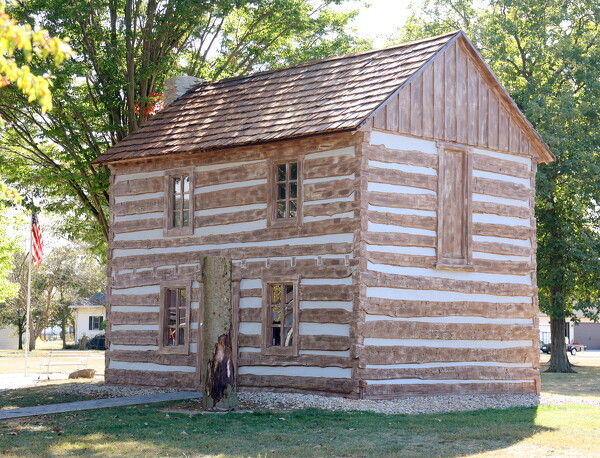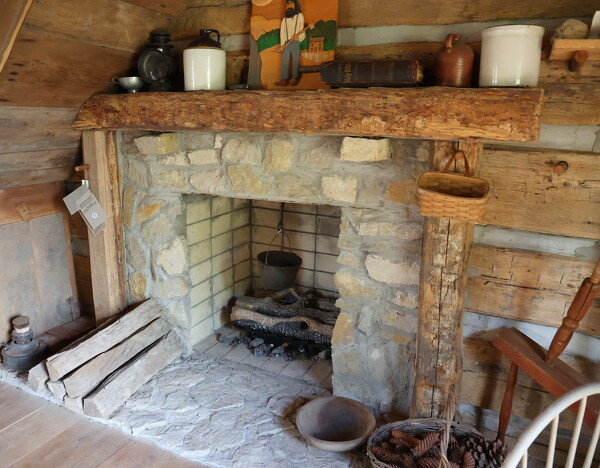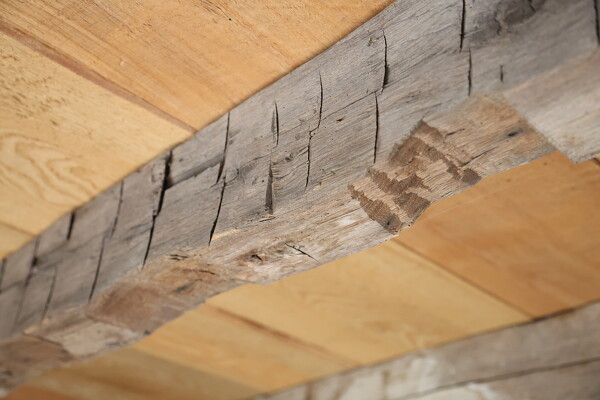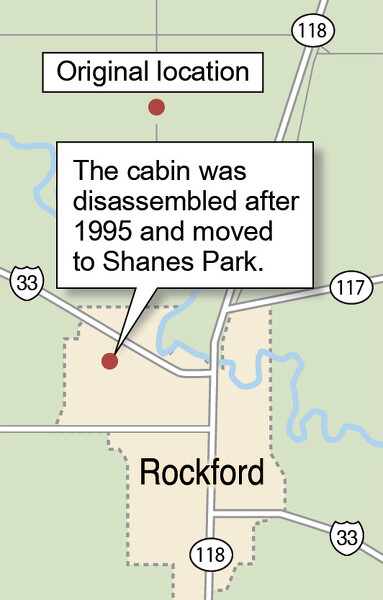
The original log cabin of Rockford's founder Anthony Shane was recently renovated. The cabin, which was built by Shane in the 1800s, is located in Shanes Park in Rockford.
ROCKFORD - Not many towns can boast they possess its founder's original log cabin home. Even fewer can claim the home is newly renovated.
But Shanes Crossing Historical Society President Mike Schumm said Rockford can. Schumm is very familiar with the village's history, especially its founder, Anthony Shane.
The log cabin, which stands inside Shanes Park, is believed to be the original home Shane built when he founded the village. To preserve history, the historical society, village officials and a Fort Recovery home improvement business gave the 200-year-old log cabin a facelift.

The fireplace inside Anthony Shane's log cabin, which is now gas-powered after renovations.
Dean Zehringer, who owns Ace of Trades in Fort Recovery, said the roughly three-month project included general maintenance and exterior and interior repairs.
Zehringer and his team of up to four employees first washed the cabin to remove loose paint and then sprayed the roof with a solution to get rid of the overgrown moss. After several weeks, they sprayed an oil-based sealer to reseal the cedar shakes on the roof, he said.
He said in several areas, the logs were rotten, so they removed and replaced them with hickory logs. They also replaced some of the areas where the chinking, a sealant that fills in the gaps between the logs, was falling out. For the larger gaps, they used wood epoxy, and the smaller cracks, caulking.
Zehringer and his team also recaulked and resealed the stone chimney before priming and painting the structure. To give the cabin a more antiqued look, Zehringer said he used a dry brush to create texture with brown paint.
The project cost about $55,000, Zehringer said.
Schumm said he is in awe of the cabin's craftsmanship, especially since Shane built the cabin himself in the 1800s.
The floor planks are sanded down but are most likely the original wood. Most of the wood is original to the cabin, he said.
"Some of the logs were replaced with barn beams from area farmers tearing down barns, but a good percentage is of the actual logs that existed at the time," he said.
Some of the cabin's more minor details are among the most fascinating to Schumm. For example, the square nails used in the cabin were meticulously handmade by a blacksmith. Additionally, several of the ceiling beams have the ax marks in them where the wood was hewn by hand, he said.

An original beam with ax marks in it where the wood was hewn by hand.
Now that the project is about finished, Schumm said he is excited to showcase the unique piece of history to the public. The cabin will be open to the public during Rocktoberfest on Oct. 26 from 1-5 p.m.
On Sunday, during the village's maker's market, he opened the cabin for members of the public to walk through and be transported in time.
The first floor of the two-story cabin is furnished with basic memorabilia from the time, including axes, oil lamps, multiple types of saws, an old baby bed, a washing board, animal traps, chairs, benches, a cobbler's stand and a vintage stone sharpening or grinding wheel.
Schumm said most of the props are from the period, but some are later. For example, the fireplace is gas-powered and the cabin is equipped with electricity.
As a history enthusiast, Schumm said village and history officials are "99% sure that it (the cabin) belonged to Anthony Shane."

The cabin of Rockford's founder, Anthony Shane, was moved into town in 1995.
"It was out on the King Farm, north of Rockford," he noted. "A local historian identified the cabin probably being (Shane's cabin) because on an old map, there was a dot that located his house. It (the cabin) pretty much sat right where that dot was. The timbers all seem to match the time period as well, so they're almost certain that was Anthony Shane's log house."
In August 1995, Glen Harper, district coordinator of the Historic Preservation Office of the Historical Society, confirmed the "double-log house is a log and chink structure typical of the time period of Anthony Shane, making it architecturally and historically significant," per the village's website.
A year later, residents began dismantling the logs and moving them to where the cabin is now - inside Shanes Park.
"They moved the log house into town," Schumm said. "Each of the logs were numbered and, of course, a couple of them had to be replaced, but it was all done through local citizens volunteering their time to put it back together. What a tremendous job they did. They did have some assistance and … the total cost of the project ended up being about $30,000."
The village was founded in 1820 by Shane, a scout, messenger, interpreter and entrepreneur who served in multiple battles throughout his life and in the War of 1812, local historian and author Harrison Frech had said.
Shane's service in the War of 1812, his leadership of the local Native American population and his willingness to use his knowledge of Native American culture and local history to aid new settlers ingratiated him to the growing white population of the area, Frech had said.
Shane was rewarded by the U.S. government for his loyalty and service and was admired as a war hero. In 1815, he received a land grant from Congress for "valuable and honorable service during the last war," Frech had said. The 320-acre grant was at the second crossing of the St. Marys River on the south side, which was dubbed Shanes Crossing.

An old rocking chair has Anthony Shane's name carved in the bottom.
Shane was later awarded another 640 acres located on the north side of the St. Marys River, directly across from his earlier land grant, for acting as an interpreter in the Fort Meigs Treaty.
Commerce grew along the river as goods were transported from St. Marys to Fort Wayne, Indiana, and to trading posts along the river. Shane took advantage of the influx of settlers and platted Shanesville in June 1820, the first platted town in the county.
Settlers could stop at Shane's tavern and trading post, Frech had said. As they went north they could travel on Shane's ferry. On the ferry ride, settlers would pass Shane's Reserve and Shane's home where he and his family raised corn, potatoes and other vegetables. Shane and his wife, Lamateshe, had two daughters and two sons with one son dying early in childhood, per the village's website. Shane also raised one stepson.
Shane used his land grant as a real estate enterprise, according to Frech. Shanesville had 42 lots.
By 1821, three houses had been built and another was under construction, and the countryside was settled for 6 miles around his new town.
Frech had said the town grew slowly at first due to its swampy environment. New roads needed to be built to allow for travel over muddy paths, and the land had to be drained to keep away mosquitoes and the malaria they carried.
Shanesville was later incorporated as Shanes Crossing in 1866 because another Shanesville in Ohio had been founded in 1814.
Although the town had already gone through a name change, the townspeople wanted to change the name again in 1889-1890 because they believed Shanes Crossing was "too frontier," Frech had said.
The townspeople voted to change the name to Lacine.
Interestingly, Schumm said the post office didn't accept Lacine as the new name because it was too similar to Racine, Ohio, and instead chose Rockford, which had come in second place. The name Rockford came from the term rocky ford, which is the low point in a river.

